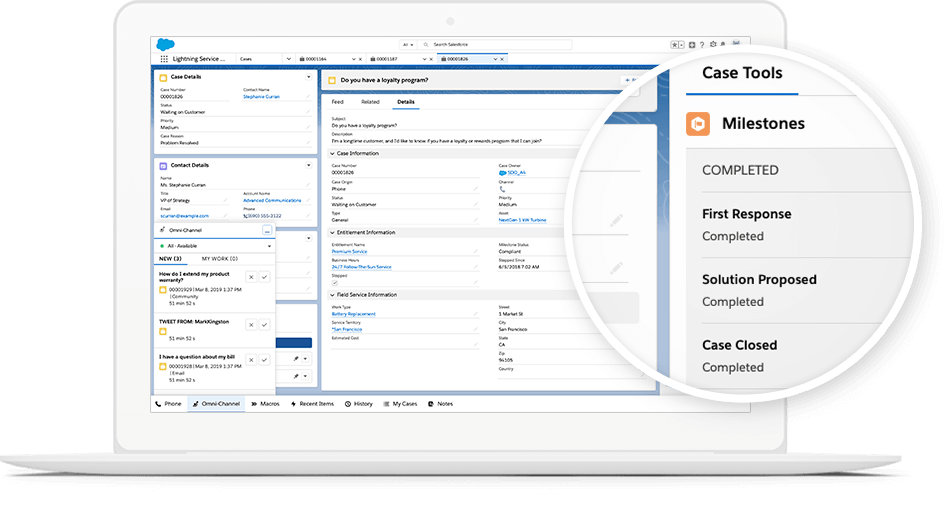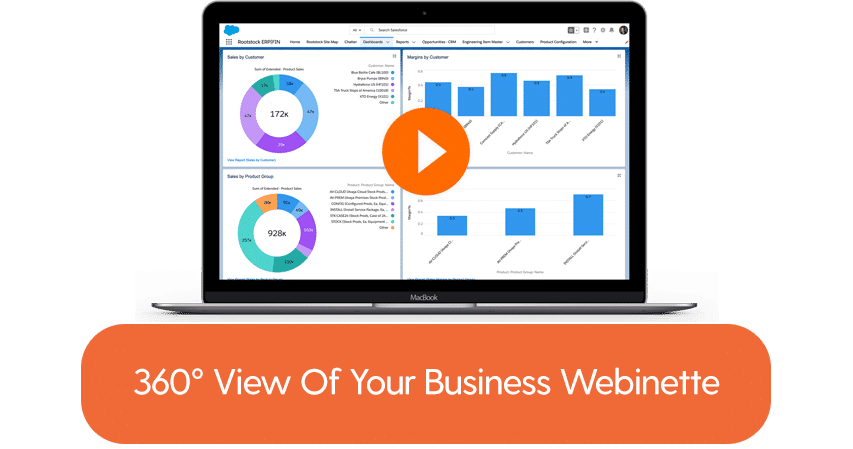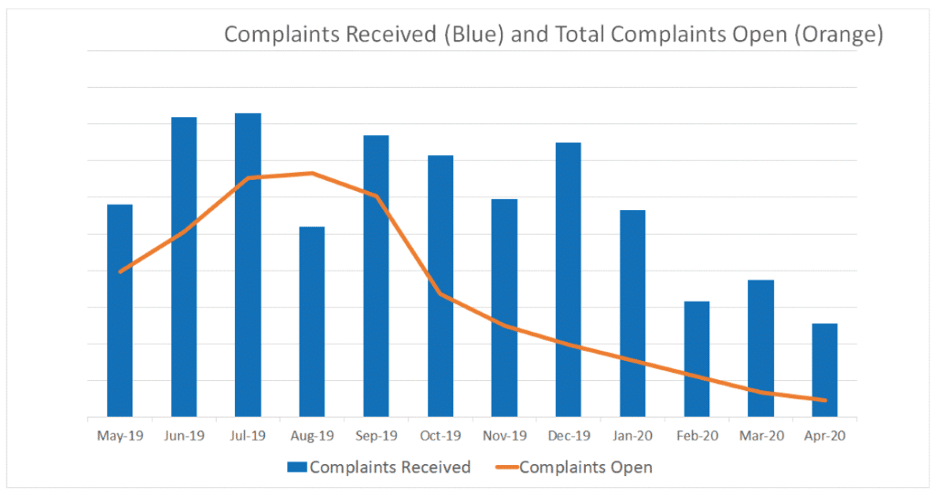What is Salesforce Service Cloud?
What is Salesforce Service Cloud, and how can Manufacturers improve customer service by combining it with Rootstock Cloud ERP?
Salesforce Service Cloud is a customer service management platform that helps companies streamline their customer service operations in order to quickly connect to customers and solve customer problems. Service Cloud lets you automate service processes, streamline workflows, and deliver a more personalized customer service experience.

Key Features and Benefits of Salesforce Service Cloud for Manufacturers
Salesforce Service Cloud offers a wide range of features and benefits for manufacturers, including:
- Case Management – Resolve cases faster by combining automated processes with easy access to the full details, context, and history of every case and customer interaction.
- Agent Workspace – Allow agents to seamlessly handle cases from a single screen with an easy-to-use service console. Equip them with built-in productivity tools and a 360-degree view of every customer.
- Knowledge Management – Drive quick case resolution and maximize agent productivity with recommended articles and optimized article search.
- Service Process Automation – Create end-to-end workflows to automate and scale repetitive business processes with drag-and-drop simplicity.
- Omni-Channel Routing – Automatically match cases from any channel – messaging, chat, social, email, and voice – to the right agent based on skill set and expertise.
- Service Analytics – Boost team efficiency using prebuilt dashboards that monitor agent performance, key KPIs and channel usage, from anywhere.

Why Does Great Service Require Seamless ERP and CRM Integration?
In this age of customer-centric manufacturing, customers expect quick answers to their support questions and quick resolution of their problems. Manufacturers are under increasing pressure to out-service their competition and to do so, they must provide their support team with every possible advantage, including a complete 360-degree view of each customer. Only a seamless integration of ERP and CRM can deliver this advantage.
Customers Expect Quick Answers
When customers contact support, they expect answers fast. There are few things more frustrating than being put on hold then transferred to another person to repeat the same information. Customers expect instant responses, and they need them now.
An underlying truth is that customers who contact support expect your employee to know everything about them. They assume that you operate as one company. When they get bounced around from department to department because employees don’t have access to either ERP or CRM information, it reflects badly on your organization.
Any employee should be able to answer such questions as “where’s my order?” or “can you provide me a copy of my invoice?”
The divide between ERP and CRM should not be the root cause of providing poor customer service. Integrating ERP and CRM bridges that divide and ensures that every member of your support team has all of the information he or she needs to answer any customer inquiry immediately. Employees can’t do their jobs unless they have access to everything – they need a real time, 360-degree view.
Processes Requiring Customer Interaction Need ERP-CRM Coordination
We can all agree that optimizing the customer experience is critical. Processes and activities that interact with customers and include ERP and CRM elements must be well coordinated. These processes and activities include sales and sales order processing, RMA processing, parts replacement processes, product revision and warranty management, and inventory questions (“is my product in stock?”). If these processes are slow, cumbersome and error prone, the customer suffers and gets caught in the gulf between CRM and ERP.
In short, your customers will experience for themselves how well or how poorly your systems are integrated.
Service Cloud Integration with Rootstock Cloud ERP
When you use Salesforce Service Cloud with Rootstock Cloud ERP, the seamless integration bridges the divide between CRM and ERP to give you all the tools you need to deliver great customer service.
Answering Customer Inquiries
Your support team can’t answer customer inquiries quickly and accurately without an integrated approach. With Service Cloud and Rootstock, service reps (or any employee for that matter) can access everything that a customer could ask from a single screen.
The goal is to increase first call resolutions and time to respond. The 360-degree view, accessible by all employees, is critical to this. It eliminates problems such as customers getting bounced around between departments and it makes your customer service reps more productive.
Order Status/Change Management
One of the most common questions from customers is “Where’s My Order?” This means all customer-facing employees need access to information inside ERP.
In the engineer-to-order environment or the make-to-order environment, customers might be calling into a help desk or to the service department to find out where their order is in the process.
A customer may want to change something in the product configuration. With Rootstock working with Service Cloud, your service reps have visibility into the customer’s case, which links to the sales order or the work order driving the process. For example, the order may be delayed somewhere in the process, or there may be a material shortage for a particular component. The service rep can drill down and see that the vendor is late on their delivery, see what the new delivery date is, or escalate it using Chatter or a task.
Researching Support History
Rootstock Cloud ERP contains information that is often vital to resolving a support call. This data is part of ERP, so integration to make this information available to customer reps is critical to customer service.
For example, Rootstock Cloud ERP data includes product configuration information by serial number, so service reps can look up device serial numbers. If a customer is calling about serial number 12345, the service rep can quickly find out when that serial number was shipped, and the sales order included associated with that serial number.
Support reps can view the history of all modifications to an item including, for example, items returned for rework. Support reps can also view all links between parents and their components for serialized items. Again, this is data available in Rootstock Cloud ERP.
Processing RMAs
To run the Return Material Authorization (RMA) process efficiently and accurately, you need both ERP and CRM.
With Rootstock Cloud ERP integrated with Salesforce, your service reps can generate RMAs from sales order shippers, invoices or Salesforce service cases and include details specific to the item being returned. For example, if the product doesn’t meet the customer’s specifications, the service rep can create an RMA that automatically links back to the original case.
The service rep can also give the customer options for replacement or repair, at no cost, partial costs or full cost, depending on the customer’s warranty. The replacement could be a loaner or it could be a replacement. If it’s a loaner for a product or device that needs to be repaired, the service rep can generate a refurbishment work order.
Warranty Servicing and Selling
To perform warranty service or upselling, service reps need ERP information. Rootstock lets service reps see whether a product is under warranty or if the customer has an extended support plan, as well as product shipping information.
Rootstock Cloud ERP lets you easily create user-defined warranty types to initialize different warranty durations and expiration dates and quickly access related transactions and customer information from linked cases, returns and service orders in the device’s history.
Complaint and Quality Management
For many manufacturers, customer service goes hand-in-hand with quality management. This is especially true in medical device manufacturing, where poor quality and customer problems can directly affect patient health and safety.
SPR Therapeutics Success Story
One company’s success story provides an ideal example. SPR Therapeutics designs, manufactures and commercializes non-opioid, minimally invasive pain treatment options.
Early on, the company discovered that their internal systems, including CRM, inventory management and quality management, did not support their business plan. They were disconnected, inefficient, and made poor use of critical data. They needed technology that would support their business, not hold them back.
SPR Therapeutics implemented Rootstock Cloud ERP, Salesforce CRM and ComplianceQuest EQMS on the Salesforce Cloud Platform. ComplianceQuest is a 100% cloud-based Enterprise Quality Management System (EQMS) natively built and run on the Salesforce platform.
Product quality and patient satisfaction are the top priority at SPR Therapeutics. Feedback from physicians and patients is essential, and complaints are used as a gauge for understanding product performance, improvements required, and priority level. Improving complaint processing had been one of SPR’s goals with the new system.
Prior to going live with their new system in August 2019, the number of open complaints was rising rapidly. Between product improvements made by the engineering team and released into the field and the improved complaint handling efficiency, the number of open complaints has significantly decreased despite a continued rise in sales.
The following graph shows SPR Therapeutics’ decline in open complaints.
Furthermore, the timeframe for investigating and resolving complaints has decreased by an average of 60%.
For more information about how SPR Therapeutics succeeded with Rootstock and Salesforce, download the Customer Story here.



